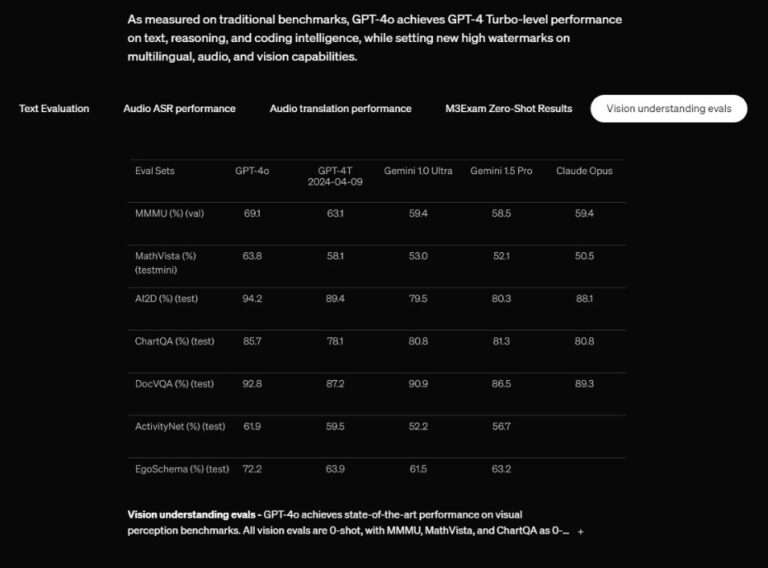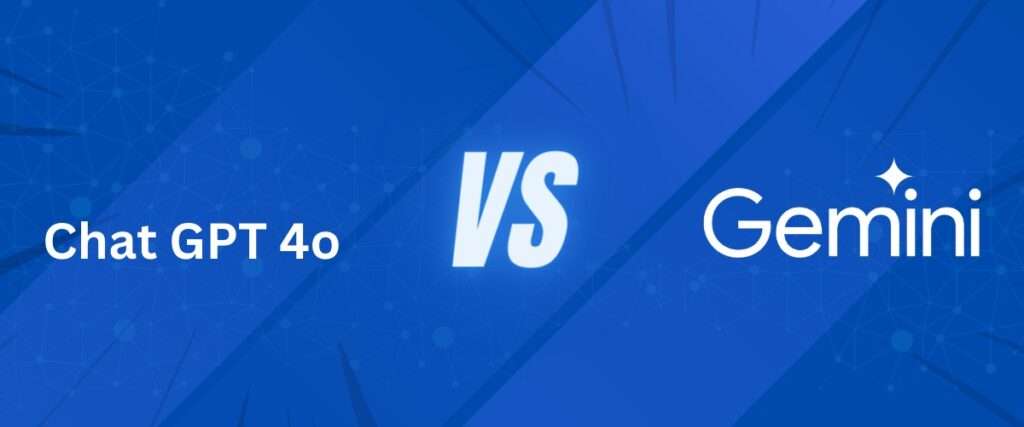OpenAI has just released its most ambitious AI model, GPT 4o (O for Omni) , a groundbreaking upgrade to its popular ChatGPT.
In a live event held at their San Francisco headquarters, OpenAI’s CEO, Sam Altman, and CTO, Mira Murati, unveiled the model, emphasising its “native multimodality” and promising a transformative shift in how we interact with AI
Available To All
This new update, GPT-4o, aims to make artificial intelligence more intuitive and accessible than ever before.
Notably, it’s available for free to all users, democratising access to GPT-4-level intelligence.
While this move may seem like a strategic play to outsmart competitors like Google, the advancements in GPT-4o’s capabilities are undeniable.
Worth The Hype?
But what exactly sets GPT-4o apart? Can it truly live up to the “magic like” OpenAI’s CEO Sam Altman teased?
Is this a genuine leap forward in AI or simply a well-timed marketing ploy?
Let’s check into the features, potential impact, and controversies surrounding this cutting-edge technology.
Multisensory AI Experience
GPT-4o isn’t just another AI chatbot; it’s a new form of interaction.
By seamlessly integrating text, audio, and visual processing, this model breaks the boundaries of traditional AI, offering an experience that feels startlingly human-like.
Real-time Conversations
Gone are the days of robotic exchanges. GPT-4o engages in fluid, natural conversations, effortlessly picking up on interruptions, understanding nuances in tone, and even expressing its own emotions – from playful banter to soothing empathy.
This heightened emotional intelligence blurs the lines between human and machine interaction, making conversations with AI feel more genuine and engaging.
Enhanced Vision

GPT-4o’s visual prowess is equally impressive.
It can analyse photos, interpret screenshots, and even read documents containing a mix of text and images.
This capability could revolutionise tasks like data extraction, document analysis, and even visual storytelling.
Imagine asking GPT-4o to summarise a complex infographic or generate a humorous content – the possibilities are endless.
ChatGPT-4o’s Voice
GPT-4o’s vocal abilities are nothing short of captivating.
The model can generate expressive speech in a variety of styles, mimicking human intonation and emotion with surprising accuracy.
This could have far-reaching implications for audio content creation, accessibility tools for the visually impaired, and even personalised storytelling experiences.
Multilingual Maestro
With improved performance and speed in over 50 languages, GPT-4o transcends linguistic boundaries.
It can translate conversations in real-time, opening up new avenues for cross-cultural communication and collaboration.
Whether you’re chatting with someone from a different country or navigating a foreign language website, GPT-4o can be your trusty interpreter.
Chatgpt-4o is Your Assistant
While GPT-4o excels at conversation, its potential goes far beyond mere chit-chat.
The model shows promise as an AI agent, capable of performing real-world tasks like booking appointments, sending emails, or even ordering food.
This glimpse into the future of AI assistants could transform the way we interact with technology, delegating routine dull tasks and freeing up our time for more meaningful pursuits.
New form of Creativity
GPT-4o’s creative potential is also awe-inspiring.
It’s been rumoured to compose music, generate 3D models, and even craft unique fonts based on textual descriptions.
This opens up a world of possibilities for artists, designers, and content creators, who can leverage AI to augment their creativity and explore new forms of expression.
Staying updated
GPT-4o’s ability to access real-time information and potentially scrape the web sets it apart from previous models.
This means it can constantly update its knowledge base, staying abreast of the latest trends, news, and discoveries.
This continuous learning capability could eventually eliminate the issue of outdated information and make GPT-4o an even more valuable tool for research, education, and personal growth.
Gemini vs. GPT-4o: The AI Titans Clash

Google’s Gemini, also multimodal, is expected to be a fierce competitor.
However, GPT-4o’s immediate availability and focus on real-time interaction, demonstrated by its faster response times and smoother handling of interruptions in live demos, give it a head start.
The race is on to see which model will ultimately win the AI landscape.
Focus
GPT-4o: Excels in real-time conversations and human-like interactions. Gemini: Designed for broader tasks, reasoning, code generation, and creative writing.
Availability
GPT-4o: Free and paid tiers within ChatGPT. Gemini: Free tier and paid “Gemini Pro” tier within the Gemini app and through APIs for developers/enterprise.
Real-Time
GPT-4o: Particularly strong in real-time conversations. Gemini: Continuously improving real-time responsiveness and conversational flow.
Languages
GPT-4o: Enhanced support in 50+ languages. Gemini: Expanding language capabilities, leveraging Google’s extensive language resources.
Integration
GPT-4o: Integrated with ChatGPT and the OpenAI API. Gemini: Integrated with the Gemini app, Google Search, and the Gemini API.
Key Concerns: Proceed with Caution
While GPT-4o’s capabilities are undeniably impressive, it’s important to temper our enthusiasm with a realistic understanding of its limitations.
Keep these concerns in mind as you explore the possibilities of GPT-4o.
Audio Limitations and Glitches
Though the real-time voice interaction is groundbreaking, the demonstration revealed occasional glitches and imperfections in audio generation and comprehension.
These glitches raise concerns about the model’s reliability in real-world scenarios, especially where precise understanding is crucial, such as in healthcare or legal settings.
Security Threats and Deepfakes
The ability to convincingly mimic human voices and generate realistic images opens the door to potential security threats and malicious uses of the technology.
Deepfakes, in particular, could be used to spread misinformation, manipulate public opinion, and even commit fraud.
Unclear Rollout of Audio & Video Features
While the text and image capabilities of GPT-4o are already available, OpenAI has not yet provided a clear timeline for the full rollout of audio and video interactions.
This uncertainty leaves users and developers in limbo, unsure of when they can fully leverage the model’s multimodal capabilities.
The Illusion of Human Connection
Despite GPT-4o’s impressive ability to mimic emotional cues, it’s crucial to remember that these are just simulations.
The model lacks genuine human emotions and understanding, which could lead to overreliance on AI for emotional support or companionship, potentially leading to social isolation and other psychological issues.
Ethical Implications of AI-Generated Content
The potential for GPT-4o to flood the internet with AI-generated content raises ethical questions about authenticity, plagiarism, and the potential devaluation of human creativity.
Additionally, there are concerns about the model’s ability to perpetuate biases and stereotypes present in its training data.
GPT-4o and the Future of Search: Adapting SEO Strategies for AI-Driven Content
The SEO landscape is on the brink of a seismic shift as GPT-4o’s content generation capabilities threaten to inundate the internet with AI-crafted articles and blog posts.
While this could lead to a surge in AI-optimised content, concerns about originality, authenticity, and overall quality are rising.
This isn’t just about OpenAI, either.
Google’s Gemini and startups like Perplexity AI are also racing to transform the search experience with generative AI.
The Double-Edged Sword of AI-Generated Content
GPT-4o’s ability to produce vast amounts of content quickly and efficiently is a double-edged sword.
On one hand, it could democratise content creation, enabling businesses and individuals to scale their output without sacrificing quality.
On the other hand, it could lead to an oversaturation of generic, formulaic content, drowning out unique human perspectives and insights.
SEO in the Age of GPT-4o: Balancing AI Efficiency with Human Expertise
The emergence of OpenAI’s GPT-4o, a powerful AI model capable of generating high-quality content across various formats, is poised to revolutionise the SEO landscape.
While this technology promises to streamline content creation and democratise access to information, it also raises concerns about originality, authenticity, and the potential oversaturation of AI-generated content.
Prominence For E-E-A-T
Search engines like Google are adapting to this new reality by emphasising E-E-A-T (Experience, Expertise, Authoritativeness, and Trustworthiness) in their algorithms.
This shift prioritises high-quality, authentic content that demonstrates real-world experience and expertise, posing a challenge for AI-generated content that often lacks a unique voice or nuanced perspective.
Maintain the Balance
To navigate this evolving landscape, SEOs must embrace AI as a tool while upholding the principles of E-E-A-T.
Experimenting with generative AI models like GPT-4o can streamline content creation, but human expertise remains essential for crafting engaging, original content that resonates with audiences.
Establishing topical authority, investing in credibility signals, and staying informed about AI advancements are also crucial for maintaining a competitive edge.
Ultimately, the key to success lies in finding the right balance between AI efficiency and human ingenuity, using AI to enhance rather than replace human creativity and expertise.
Creative Fuel: The AI War Begins
OpenAI’s launch of GPT-4o, their latest multimodal AI model, just before Google’s I/O conference, marks the escalation of the AI arms race between the two tech giants.
Both companies are pushing the boundaries of AI, with Google expected to showcase advancements in its Gemini model and new Android 15 features.
This competition promises to drive innovation and shape the future of AI technology.
Conclusion
GPT-4o, OpenAI’s groundbreaking multimodal AI, opens a world of possibilities, transforming communication, creativity, and industries.
Its ability to seamlessly integrate text, audio, and visual processing brings us closer to a future where human-AI interaction is more natural and intuitive than ever before.
While GPT-4o Omni presents exciting possibilities for AI, it’s crucial to use it responsibly and ethically.
AI should enhance, not replace, human creativity and connection.
By leveraging AI as a tool, we can unlock new levels of productivity and innovation while preserving the essential human elements that make us who we are.